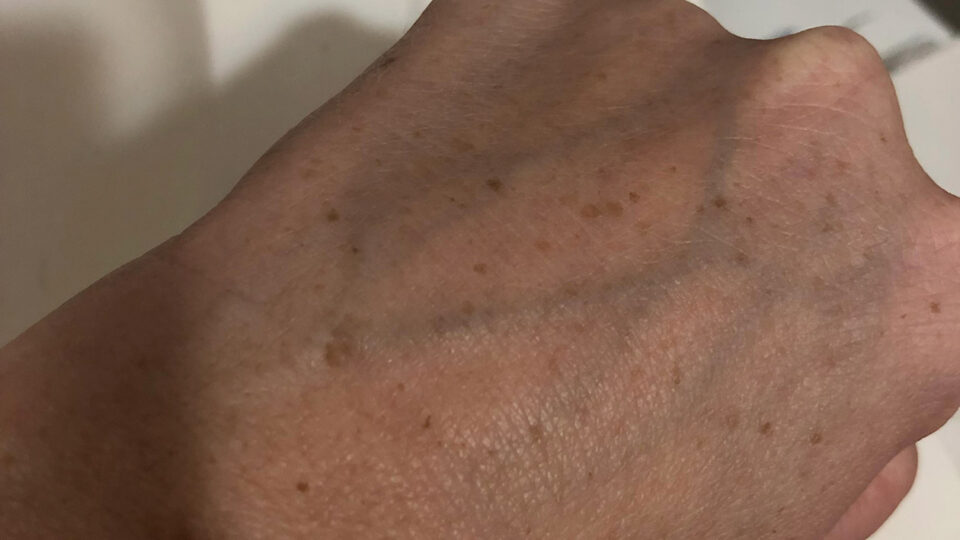What Causes Age Spots?
Age spots, also known as liver spots or solar lentigines, are primarily caused by prolonged exposure to ultraviolet (UV) light from the sun or artificial sources like tanning beds. They form when the body produces excess melanin, the pigment that gives skin its colour. This overproduction of melanin is triggered by:
- UV Light Exposure: Years of sun exposure or the use of tanning beds stimulate melanin production as a protective mechanism against UV damage.
- Aging: As we get older, the skin becomes more susceptible to UV damage, leading to increased melanin production in certain areas.
Several factors can increase your likelihood of developing age spots:
- Age: They are more common in people over 40, though younger individuals can develop them too.
- Skin Type: Fair-skinned individuals are more prone to age spots.
- Sun Exposure History: Frequent or intense sun exposure increases the risk.
- Tanning Bed Use: Artificial UV light from tanning beds can also cause age spots
Where do Age Spots appear?
Age spots typically appear on areas of the skin that receive the most sun exposure over time, including:
- Face
- Backs of hands
- Shoulders
- Upper back
- Forearms
- Tops of feet
Age Spot Removal
Age spots are harmless and typically respond well to treatment. However, it’s important to distinguish them from similar-looking skin lesions. One such lesion is seborrheic keratosis. Seborrheic keratoses appear as waxy, brown, black, or tan growths. They are often slightly raised or elevated. Unlike flat age spots, they have a more textured, “stuck-on” appearance.
Seborrheic keratoses are common non-cancerous skin growths in older adults. They often appear in multiples. While also harmless, they can be more challenging to remove than age spots. They may require more intensive treatments.
How can I get rid of Age Spots?
Laser Treatment
Laser therapy provides a highly effective method for removing age spots. Lasers emit specific wavelengths of light that target melanin, the pigment responsible for age spots.
The light energy is absorbed by the melanin, causing the pigment to break down and be naturally eliminated by the body. This process results in a lightening or complete disappearance of the age spot.
Several types of laser treatments are available for age spot removal:
- Intense Pulsed Light (IPL): IPL delivers broad-spectrum light energy to target melanin. It is popular for treating various skin concerns, including age spots, ssun damage, and rosacea.
- Fractional Lasers: These lasers create microscopic columns of thermal injury in the skin, stimulating collagen production and promoting skin rejuvenation. They are effective for treating age spots, fine lines, and wrinkles. Examples include Fraxel and CO2 lasers.
- Genius RF: Genius RF is a newer laser treatment that uses thermo-mechanical ablative technology. It delivers direct heat to the skin, creating controlled micro-injuries. This stimulates collagen and elastin production and improves skin tone and texture, effectively reducing the appearance of age spots. Genius RF offers minimal downtime compared to other ablative lasers.
The choice of laser depends on the individual’s skin type, the size and location of the age spots, and other factors. A Registered Nurse from The Cosmetic Studio Noosa can assess your specific needs and recommend the most appropriate laser treatment for optimal results.
Chemical Peels
VI Peels offer a versatile and effective solution for treating age spots. These unique chemical peels blend synergistic ingredients to exfoliate the skin, stimulate collagen production, and address hyperpigmentation concerns. Unlike traditional chemical peels, VI Peels are safe for most skin types, including darker complexions.
The VI Peel is particularly effective for age spots. Its targeted formula blends acids, vitamins, and minerals to penetrate the skin and break up melanin clusters, the cause of age spots. This peel also incorporates a booster system to enhance pigment reduction and improve overall skin tone.
The benefits of VI Peels for age spot removal extend beyond simple exfoliation. They improve skin texture, reduce the appearance of fine lines and wrinkles, and stimulate collagen production for firmer, more youthful-looking skin.
The unique post-peel kit provided with VI Peels also ensures optimal healing and enhances the treatment’s long-term effectiveness. A consultation with a Registered Nurse from The Cosmetic Studio Noosa will determine the most suitable VI Peel for your individual needs and skin type.
Microdermabrasion
Microdermabrasion is a non-invasive cosmetic procedure that can help reduce the appearance of age spots. It involves using a handheld device to exfoliate the outermost layer of skin gently. This process removes dead skin cells and stimulates cell turnover, revealing fresher, more evenly toned skin underneath.
While microdermabrasion can help lighten age spots, it’s generally more effective for treating superficial pigmentation. Other treatments like chemical peels or laser therapy may be more suitable for deeper or more pronounced age spots.
Microdermabrasion can be a valuable part of a comprehensive skin rejuvenation plan. It can be combined with other treatments for enhanced results. It’s a relatively gentle procedure with minimal downtime, making it a convenient option for those seeking subtle skin tone and texture improvements.
